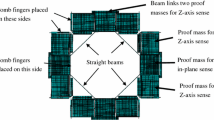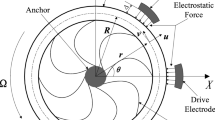Abstract
MEMS (micro-electromechanical system) vibratory gyroscopes have attracted a lot of interest recently and these gyroscopes made their way through portable devices and smart phones. However, their performance is not enough to cope with the demanding requirements of applications such as dead reckoning. Mode-matched gyroscopes can be a solution for this problem. Various mode-matched gyroscope architectures have been proposed and their noise performances have been analyzed in detail. However, in most of these analyses zero-rate output was considered and the noise analysis for dynamic cases were ignored. In this paper, we demonstrate the noise analysis of mode-matched vibratory gyroscope using the power spectral density (PSD) and the Allan deviation methods while in rotation. We show that for mode-matched gyros the noise performance of a rotating gyro can be significantly different from that of a gyro that does not experience any rotation. We also show that this difference is due to the coupling between the drive and sense systems via Coriolis force. This sets a fundamental limit for the noise performance of mode-matched vibratory gyroscopes where ARW (angle random walk) increases proportionally with the rotation rate for the open loop and the force to rebalance operation modes.




















Similar content being viewed by others
References
Acar C, Shkel A (2008) MEMS vibratory gyroscopes: structural approaches to improve robustness. Springer, Berlin
Allan DW (1966) Statistics of atomic frequency standards. Proc IEEE 54:221–230
Allen JJ (2005) Micro electro mechanical system design. CRC Press, USA
Annovazzi-Lodi V, Merlo S (1999) Mechanical-thermal noise in micromachined gyros. Microelectron J 30:1227–1230
Ayazi F, Najafi K (2001) A harpss polysilicon vibrating ring gyroscope. J Microelectromech Syst 10:169–179
Bae SY, Hayworth KJ, Yee KY, Shcheglov K, Wiberg DV (2002) High-performance mems microgyroscope. In: Design, Test, Integration, and Packaging of MEMS/MOEMS 2002, International Society for Optics and Photonics. pp. 316–324
Caughey T (1960) Random excitation of a system with bilinear hysteresis. J Appl Mech 27:649–652
Cetin H, Yaralioglu GG (2016) Analysis of vibratory gyroscopes: drive and sense mode resonance shift by coriolis force. IEEE Sens J 17:347–358
Ding X, Jia J, Gao Y, Li H (2017) Mechanical and electrical noise in sense channel of mems vibratory gyroscopes. Sensors 17:2306
Dixon RH, Bouchaud J (2006) Markets and applications for mems inertial sensors. In: MEMS/MOEMS Components and Their Applications III, International Society for Optics and Photonics. 611306
Effa D, Abdel-Rahman E, Yavuz M (2013) Cantilever beam microgyroscope based on frequency modulation. In: 2013 IEEE/ASME International Conference on Advanced Intelligent Mechatronics, IEEE. 844–849
El-Sheimy N, Hou H, Niu X (2007) Analysis and modeling of inertial sensors using allan variance. IEEE Trans Instrum Meas 57:140–149
Eminoglu B, Yeh YC, Izyumin II, Nacita I, Wireman M, Reinelt A, Boser BE (2016) Comparison of long-term stability of am versus fm yroscopes. In: 2016 IEEE 29th International Conference on Micro Electro Mechanical Systems (MEMS), IEEE. 954–957
Gabrielson TB (1993) Mechanical-thermal noise in micromachined acoustic and vibration sensors. IEEE Trans Electron Dev 40:903–909
Gallacher BJ, Hedley J, Burdess JS, Harris AJ, Rickard A, King DO (2005) Electrostatic correction of structural imperfections present in a microring gyroscope. J Microelectromech Syst 14:221–234
Hu Z, Gallacher B (2018) A mode-matched force-rebalance control for a mems vibratory gyroscope. Sens Actuators, A 273:1–11
Joubert SV, Shatalov MY, Fay TH (2014) On numerically solving an eigenvalue problem arising in a resonator gyroscope. Appl Math Comput 246:561–571
Leland RP (2005) Mechanical-thermal noise in mems gyroscopes. IEEE Sens J 5:493–500
Mohd-Yasin F, Nagel D, Korman C (2009) Noise in mems. Meas Sci Technol 21:012001
Moussa H, Bourquin R (2006) Theory of direct frequency output vibrating gyroscopes. IEEE Sens J 6:310–315
Prikhodko IP, Gregory JA, Clark WA, Geen JA, Judy MW, Ahn CH, Kenny TW (2016) Mode-matched mems coriolis vibratory gyroscopes: Myth or reality? In: 2016 IEEE/ION Position, Location and Navigation Symposium (PLANS), IEEE. 1–4
Prikhodko IP, Zotov SA, Trusov AA, Shkel AM (2011) Sub-degree-per-hour silicon mems rate sensor with 1 million q-factor. In: 2011 16th International Solid-State Sensors, Actuators and Microsystems Conference, IEEE. 2809–2812
Raper J, Gartner G, Karimi H, Rizos C (2007) A critical evaluation of location based services and their potential. J Location Based Serv 1:5–45
Sachs D, Nasiri S, Goehl D (2006) Image tabilization technology overview. InvenSense Whitepaper
Shkel AM (2006) Type i and type ii micromachined vibratory gyroscopes. In: 2006 IEEE/ION position, location, and navigation symposium, IEEE. 586–593
Sonmezoglu S (2012) A high performance automatic mode-matched mems gyroscope. Master’s thesis. Middle East Technical University. Ankara, Turkey
Sonmezoglu S, Alper SE, Akin T (2014) An automatically mode-matched mems gyroscope with wide and tunable bandwidth. J Microelectromech Syst 23:284–297
Sonmezoglu S, Alper SE, Akin T (2014) An automatically mode-matched mems gyroscope with wide and tunable bandwidth. J Microelectromech Syst 23:284–297
Trusov AA, Prikhodko IP, Zotov SA, Shkel AM (2011) Low-dissipation silicon tuning fork gyroscopes for rate and whole angle measurements. IEEE Sens J 11:2763–2770
Vagner M, Beneš P, Havránek Z (2012) Experience with allan variance method for mems gyroscope performance characterization. In: 2012 IEEE International Instrumentation and Measurement Technology Conference Proceedings, IEEE. 1343–1347
Vukmirica V, Trajkovski I, Asanovic N (2010) Two methods for the determination of inertial sensor parameters. Sci Tech Rev r60, 27–33
Yazdi N, Ayazi F, Najafi K (1998) Micromachined inertial sensors. Proc IEEE 86:1640–1659
Zaman M, Sharma A, Ayazi F (2006) High performance matched-mode tuning fork gyroscope. In: 19th IEEE International Conference on Micro Electro Mechanical Systems, IEEE, pp 66–69
Zaman MF, Sharma A, Hao Z, Ayazi F (2008) A mode-matched silicon-yaw tuning-fork gyroscope with subdegree-per-hour allan deviation bias instability. J Microelectromech Syst 17:1526–1536
Zotov SA, Trusov AA, Shkel AM (2012) High-range angular rate sensor based on mechanical frequency modulation. J Microelectromech Syst 21:398–405
Funding
This work was supported by the Scientific and Technological Research Council of Turkey under Grant 114E592.
Author information
Authors and Affiliations
Corresponding author
Additional information
Publisher's Note
Springer Nature remains neutral with regard to jurisdictional claims in published maps and institutional affiliations.
Rights and permissions
Springer Nature or its licensor holds exclusive rights to this article under a publishing agreement with the author(s) or other rightsholder(s); author self-archiving of the accepted manuscript version of this article is solely governed by the terms of such publishing agreement and applicable law.
About this article
Cite this article
Cetin, H., Yaralioglu, G. Noise analysis of mode matched vibratory gyroscopes. Microsyst Technol 29, 35–47 (2023). https://doi.org/10.1007/s00542-022-05365-x
Received:
Accepted:
Published:
Issue Date:
DOI: https://doi.org/10.1007/s00542-022-05365-x




